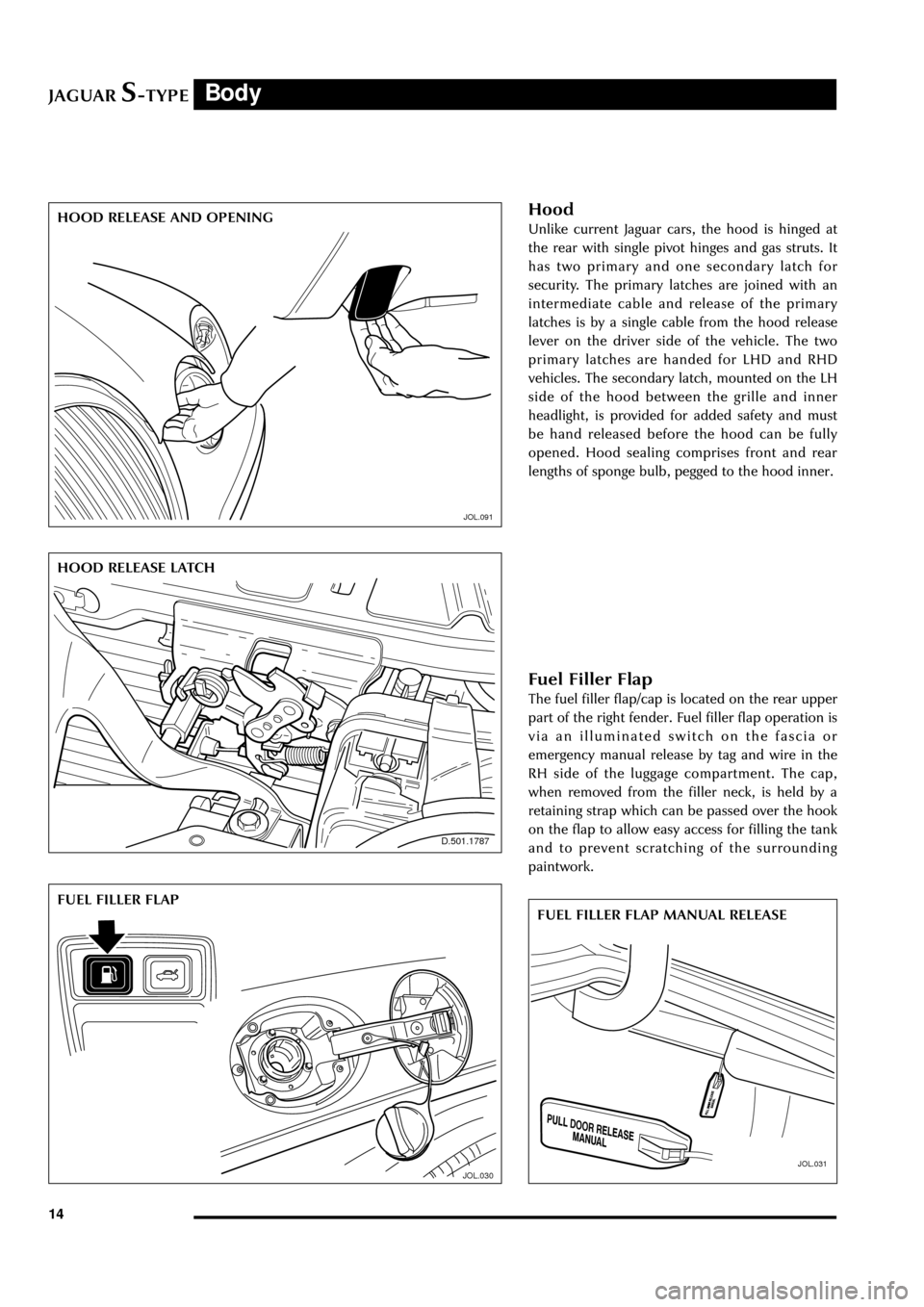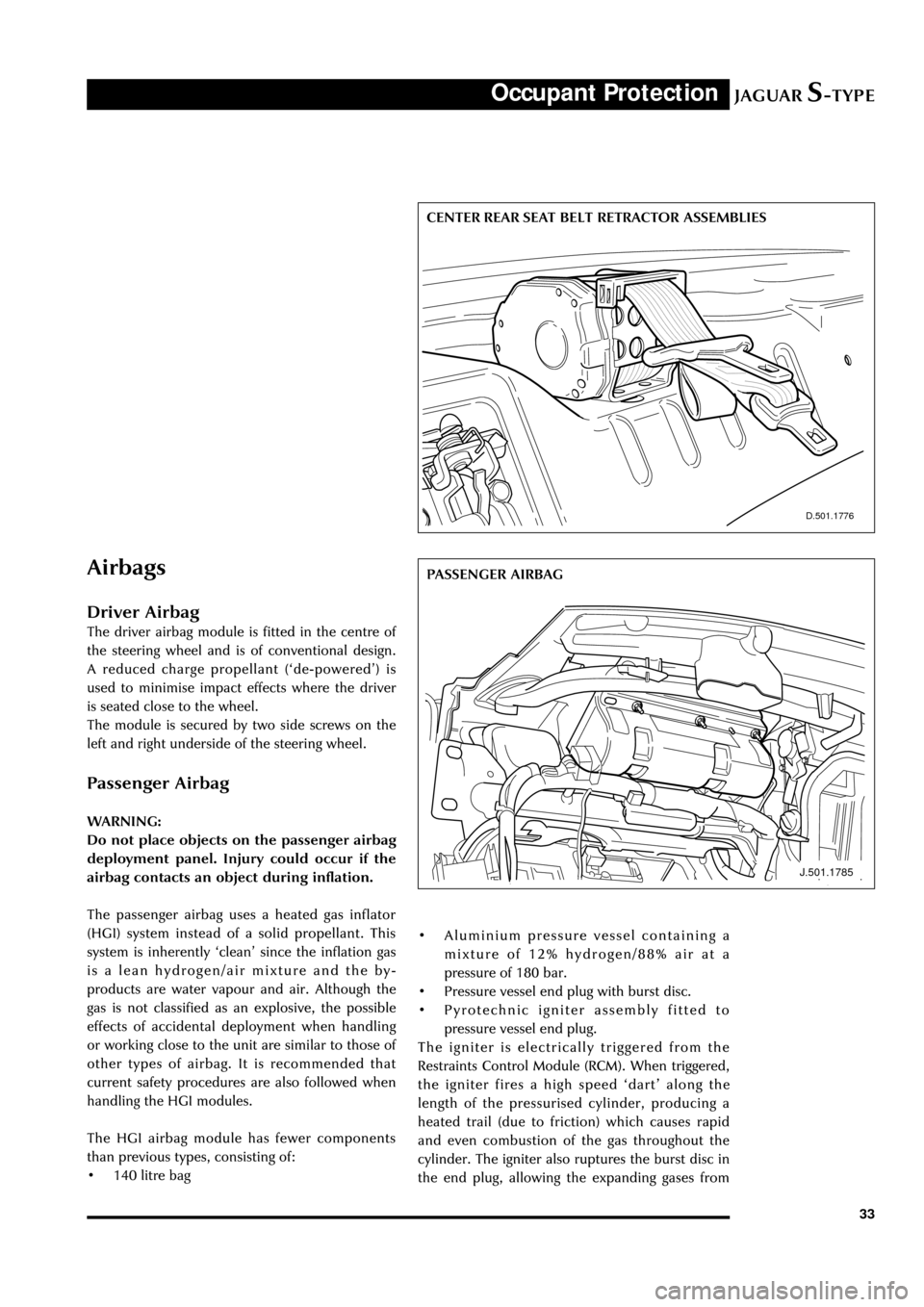gas type JAGUAR S TYPE 2005 1.G Technical Guide Update
[x] Cancel search | Manufacturer: JAGUAR, Model Year: 2005, Model line: S TYPE, Model: JAGUAR S TYPE 2005 1.GPages: 133, PDF Size: 3.48 MB
Page 19 of 133

JAGUARS-TYPEBody
14
Hood
Unlike current Jaguar cars, the hood is hinged at
the rear with single pivot hinges and gas struts. It
has two primary and one secondary latch for
security. The primary latches are joined with an
intermediate cable and release of the primary
latches is by a single cable from the hood release
lever on the driver side of the vehicle. The two
primary latches are handed for LHD and RHD
vehicles. The secondary latch, mounted on the LH
side of the hood between the grille and inner
headlight, is provided for added safety and must
be hand released before the hood can be fully
opened. Hood sealing comprises front and rear
lengths of sponge bulb, pegged to the hood inner.
JOL.091
HOOD RELEASE AND OPENING
JOL.091
JOL.030
FUEL FILLER FLAP
JOL.031
FUEL FILLER FLAP MANUAL RELEASE
Fuel Filler Flap
The fuel filler flap/cap is located on the rear upper
part of the right fender. Fuel filler flap operation is
via an illuminated switch on the fascia or
emergency manual release by tag and wire in the
RH side of the luggage compartment. The cap,
when removed from the filler neck, is held by a
retaining strap which can be passed over the hook
on the flap to allow easy access for filling the tank
and to prevent scratching of the surrounding
paintwork.
D.501.1787
HOOD RELEASE LATCH
Page 38 of 133

JAGUARS-TYPEOccupant Protection
33
Airbags
Driver Airbag
The driver airbag module is fitted in the centre of
the steering wheel and is of conventional design.
A reduced charge propellant (Ôde-poweredÕ) is
used to minimise impact effects where the driver
is seated close to the wheel.
The module is secured by two side screws on the
left and right underside of the steering wheel.
Passenger Airbag
WARNING:
Do not place objects on the passenger airbag
deployment panel. Injury could occur if the
airbag contacts an object during inflation.
The passenger airbag uses a heated gas inflator
(HGI) system instead of a solid propellant. This
system is inherently ÔcleanÕ since the inflation gas
is a lean hydrogen/air mixture and the by-
products are water vapour and air. Although the
gas is not classified as an explosive, the possible
effects of accidental deployment when handling
or working close to the unit are similar to those of
other types of airbag. It is recommended that
current safety procedures are also followed when
handling the HGI modules.
The HGI airbag module has fewer components
than previous types, consisting of:
¥ 140 litre bag
D.501.1776
CENTER REAR SEAT BELT RETRACTOR ASSEMBLIES
J.501.1785
PASSENGER AIRBAG
¥ Aluminium pressure vessel containing a
mixture of 12% hydrogen/88% air at a
pressure of 180 bar.
¥ Pressure vessel end plug with burst disc.
¥ Pyrotechnic igniter assembly fitted to
pressure vessel end plug.
The igniter is electrically triggered from the
Restraints Control Module (RCM). When triggered,
the igniter fires a high speed ÔdartÕ along the
length of the pressurised cylinder, producing a
heated trail (due to friction) which causes rapid
and even combustion of the gas throughout the
cylinder. The igniter also ruptures the burst disc in
the end plug, allowing the expanding gases from
Page 39 of 133

JAGUARS-TYPEOccupant Protection
34
D.501.1474
SIDE AIRBAGS the pressure vessel to inflate the airbag. The
airbag is a top mounted assembly and deploys in
an upwards direction, climbing the windshield
before folding downwards. After deployment, the
bag deflates through two vents.
The airbag deployment door is an integral part of
the top fascia moulding. The airbag module is
bolted to the underside of the fascia via a steel
deployment chute and is also bolted to two
brackets on the tubular cross car beam which
supports the fascia assembly.
Note:The module is not handed. To access the
airbag module, the complete fascia assembly must
be removed.
Side Airbag
Side airbags are incorporated into the driver and
front passenger seat squabs and are similar to
those fitted to the XJ Series, using compressed
argon to provide the inflation gas. The bag has a
capacity of 19 litres and provides protection to
both the head and chest regions.
The side airbag module is fixed to the outer seat
frame and is located within a fabric deployment
pocket. The pocket is stitched to the seat cover
seam and when the module is triggered, this
length of seam bursts to provide the deployment
exit for the airbag.
D.501.1474
If a damaged seat cover is to be replaced, the side
airbag module must be removed and re-located in
the deployment pocket of the new seat cover.
The complete seat must be replaced if the airbag
has been deployed.